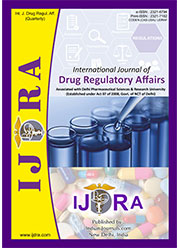A comparative study on regulatory requirement of parenteral dosage form for various regulated countries
Abstract
Parenteral products are at present extensively used for the emergency situation, as it gives maximum bioavailability. Parenteral product legislation is vital because if not sterile, nonpyrogenic can cause severe damage to health causing life-threatening danger to patient. From the above findings it is concluded that the US, being the world's biggest pharma market, also accounts for the largest chunk of the overall injectable space. For the registration of Parenteral product, TGA adopted some (not all) EU guidelines. On the other hand, health Canada mostly follows USFDA regulation guidelines for the submission of the drug product. As discussed above comparative study of regulation and registration process for Parenteral dosage form will be useful regulatory point of view as well as business development point. With this overview the Industry can harmonize dossier application in better way, which will help in reducing time for products to go in market.
Downloads
References
https://jddtonline.info/index.php/jddt/article/view/1854
2. Parenteral Packaging Market by Product Type, By Material and by Region: Industry Analysis, Market Share, Revenue Opportunity, Competition and Forecast 2020-2027 [Internet]. FutureWise;2023 [cited 2023 Jan 21]. Available from:
https://www.futurewiseresearch.com/healthcare-market-research/Parenteral-PackagingMarket/93
3. Llamas M. How the FDA Regulates and Approves parenteral Drugs [Internet]. drugwatch;2023 Jan 31 [cited 2023 Feb 22]. Available from:
https://www.drugwatch.com/fda/
4. Gorsky I. Sterile Manufacturing: Future Trends and Challenges [Internet]. contractpharma;2017 [cited 2023 Feb 23]. Available from:
https://www.contractpharma.com/sterile-manufacturing-future-trends-and-challenges
5. Dongare S, Mali S, Patrekar P. Sterile parenteral products: a narrative approach. JDDT [Internet].2015 Jan 13[cited 2023 Feb 21];5(1):41-8. Available from:
https://jddtonline.info/index.php/jddt/article/view/1047
6. Saad Ali H. A Comprehensive Review in Parenteral Formulations. Acta Sci Pharm Sci. 2020;4(7):33-41.
doi:10.31080/asps.2020.04.0554
7. Jawahar N, Vidhya Lakshmi T. Regulatory requirements for the drug approval process in US, Europe and India. J Pharm Sci Res. 2017;9(10):1943-1952.
8. Mumeena S. Comparison of Regulatory Requirements for Generic Drugs Dossier Submission in United States, Europe and Canada. Int J Pharma Chem Res. 2017;3(2):369-396.
http://www.ijpacr.com/files/07-04-2017/35.pdf.
9. Kumar M, Venkatesh MP, Kumar TMP. Review Article Strategic planning for regulatory submission of injectables / parenterals. 2020;7(2):30-36.
10. Investigational New Drug Application IND Application Template (mssm.edu) [Internet]. New York: Icahn School of Medicine at Mount Sinai;2016 Feb 24 [cited 2023 Feb 21]. Available from:
https://icahn.mssm.edu/files/ISMMS/Assets/Research/Research%20Portal/ORS/6_IND_Application.pdf
11. Jawahar N, Shrivastava N, Ramachandran A, Baviya Priyadharshini R. Procedures and applications for marketing authorisation of medicinal products in European union. J Pharm Sci Res. 2015;7(4):219-225.
12. Gupta NV. Comparative Study of Generic Drug Approval process in EU, USA and China. 2017;42(14):67-73.
13. Makvana P, Maheshwari D. Regulatory Requirements for Marketing Authorization of Generic Parentral Product in European Conutries by Decentralised Procedure. JPSBR. 2014;4(2):145- 149.
14. The European regulatory system for medicines A consistent approach to medicines regulation across the European Union [Internet]. EU: europa.eu;2014 [cited 2023 Feb 22]. Available from:
https://www.europarl.europa.eu/meetdocs/2014_2019/documents/envi/dv/ema_promo_/ema_promo_en.pdf
15. Sandeep D S, Raj K A, Narayanan V A, Dubey, A, & Jose J. Regulatory Approval Process for Drugs in Canada-A Challenging Task. Research Journal of Pharmacy and Technology. 2019;12(7):3206-10.
16. Meghraj S. An overview on comparative study of registration requirements for generics in US, Canada and Europe. International Journal of Research in Pharmaceutical Sciences and Technology. 2020;1(4):117-123.
17. India PEPC of Regulatory & Market Profile of Australia [Internet]. Pharmexcil;2018 [cited 2023 Feb 22]. Available from:
https://pharmexcil.com/uploads/countryreports/Australia-_Regulatory_Market_Profile.pdf
18. Sai Kumari B., Sai Hanuja G., Nagabhushanam M.V., D. Nagarjuna Reddy BB. Current Regulatory Requirements for Registration of Medicines, Compilation and Submission of Dossier in Australian Therapeutic Goods Administration. Int J Adv Sci Tech Res. 2016;6(6):144-157.
19. Bhargava, N.S., Shah, D.B., Maheshwari, D.G. Comparative Study of Regulation and Registration Process of Parenteral Product in US and Malaysia. International Journal for Pharmaceutical Research Scholars (IJPRS). 2015;4(1):74-81.
20. Regulatory and market profile of Australia (pharmexcil.com) [Internet]. Pharmexcil;2018 [cited 2023 Feb 22]. Available from:
https://pharmexcil.com/uploads/countryreports/Australia-_Regulatory_Market_Profile.pdf
21. Vaughan, G. The Australian drug regulatory system. Australian Prescriber. 1995;18:69-71.

This work is licensed under a Creative Commons Attribution-NonCommercial 4.0 International License.
The International Journal of Drug Regulatory affairs require a formal written transfer of copyright from the author(s) for each article published. We therefore ask you to complete and return this form, retaining a copy for your records. Your cooperation is essential and appreciated. Any delay will result in a delay in publication.
I/we have read and agree with the terms and conditions stated Page 2 of this agreement and I/we hereby confirm the transfer of all copyrights in and relating to the above-named manuscript, in all forms and media, now or hereafter known, to the International Journal of Drug Regulatory affairs, effective from the date stated below. I/we acknowledge that the IJDRA is relying on this agreement in publishing the above-named manuscript. However, this agreement will be null and void if the manuscript is not published in the IJDRA.
Download link for COPYRIGHT FORM







